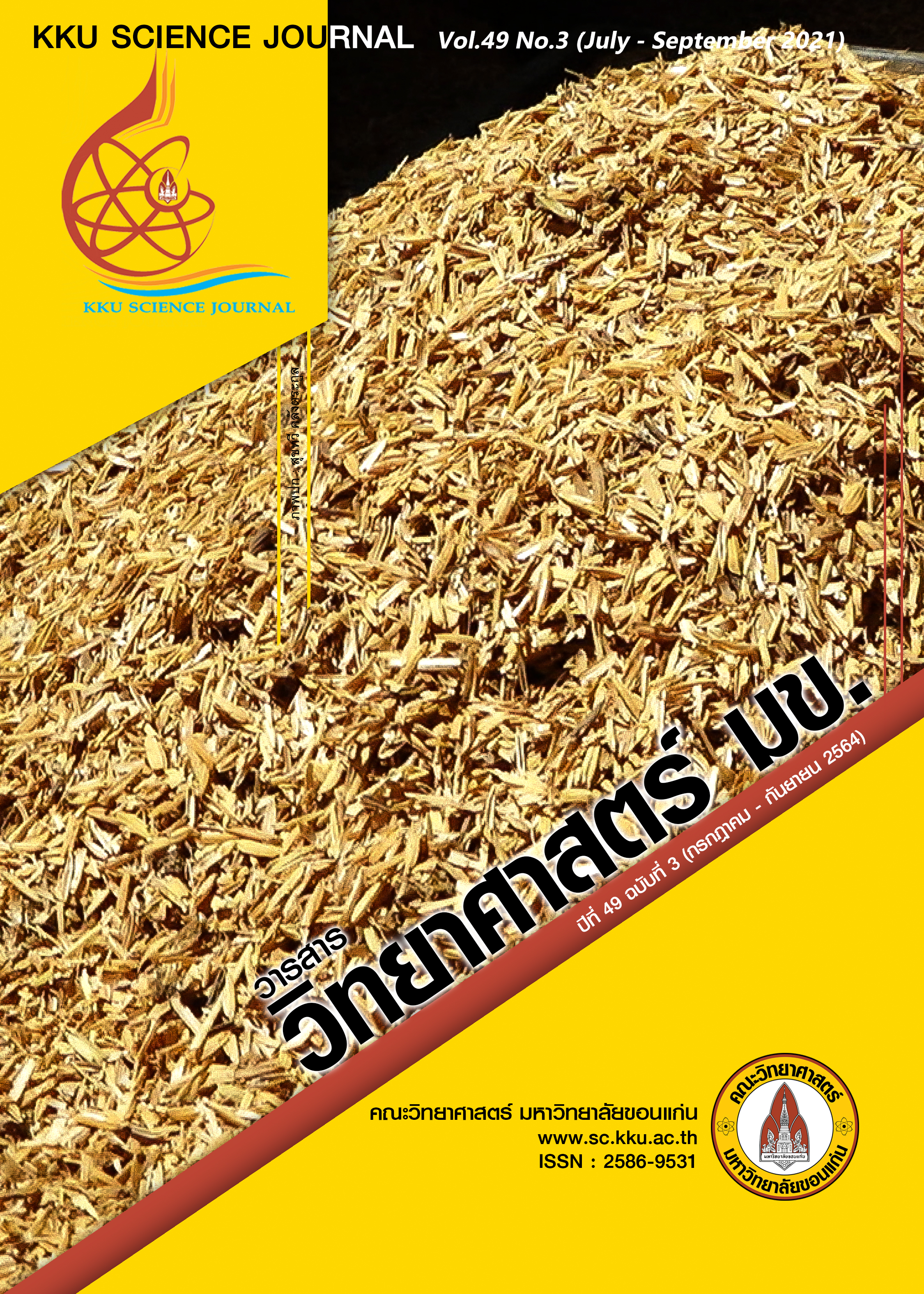การสร้างแผ่นเส้นใยโพลีโพรพิลีนแบบไม่ถักทอจากเครื่องเมลต์โบลวน์ สำหรับการดูดซับน้ำมัน
Main Article Content
บทคัดย่อ
ในงานวิจัยนี้ได้สร้างเครื่องเมลต์โบลวน์ (Melt Blown) เพื่อผลิตเส้นใยโพลีโพรพิลีนแบบไม่ถักทอสําหรับใช้ในการดูดซับนํ้ามัน ได้ศึกษาผลของอุณหภูมิหัวพ่น (170°C 190°C 210°C และ 230°C) ที่มีผลต่อลักษณะของเส้นใยและค่ามุมสัมผัสของเส้นใยโพลีโพรพิลีน ทดสอบความสามารถในการดูดซับนํ้ามันของเส้นใยโพลีโพรพิลีนที่เตรียมได้โดยมาตรฐาน ASTM-F726-12 โดยวัดค่าของการดูดซับนํ้ามันสูงสุดหลังจากดูดซับนํ้ามันแล้วเป็นเวลา 3 วินาที พบว่าความสามารถในการดูดซับนํ้ามันสูงสุดจะมีค่าลดลงเมื่ออุณหภูมิของหัวพ่นมีค่าสูงขึ้น โดยมีค่าเท่ากับ 20.78±1.46 19.40±1.26 16.34±0.48 และ 11.57±2.53 (g/g) เมื่ออุณหภูมิของหัวพ่นมีค่าเป็น 170°C 190°C 210°C และ 230°C ตามลําดับ ทั้งนี้เป็นเพราะว่าถ้าอุณหภูมิของหัวพ่นสูงขึ้นเส้นใยที่ได้จะมีลักษณะเชื่อมติดกันกับเส้นใยรอบข้างทําให้เส้นใยมีขนาดใหญ่และบางส่วนจะจับรวมกันเป็นก่อนส่งผลให้ช่องว่างระหว่างเส้นใยลดลง ทําให้พื้นที่ผิวสัมผัสของแผ่นเส้นใยมีค่าลดลง ผลการทดสอบการดูดซับนํ้ามันในช่วงเวลา 10-60 นาที พบว่าทุกตัวอย่างมีอัตราการดูดซับนํ้ามันลดลงตามเวลาเป็นแบบไม่เชิงเส้น อย่างไรก็ตามเส้นใยโพลีโพรพิลีนแบบไม่ถักทอเตรียมที่อุณหภูมิหัวพ่นเท่ากับ 170°C จะมีความสามารถในการดูดซับนํ้ามันได้ดีที่สุดเพราะมีลักษณะการผสานกันของเส้นใยที่สมํ่าเสมอและมีสมบัติความไม่ชอบนํ้าที่สูงมากกว่าตัวอย่างอื่น
Article Details

This work is licensed under a Creative Commons Attribution-NonCommercial-NoDerivatives 4.0 International License.
References
Abdullah, M. A., Rahmah, A .U. and Man, Z. (2010). Physicochemical and sorption characteristics of
Malaysian ceiba pentandra (L.) gaertn. As a natural oil sorbent. Journal of Hazardous Materials 177(1-3): 683-691.
Al-Majed, A. A., Adebayo, A. R. and Hossain, M. E. (2012). A sustainable approach to controlling oil spills. Journal of Environmental Management 113: 213-227.
Bazargan, A., Sadeghi, H., Garcia-Mayoral, R. and Mckay, G. (2015). An unsteady state retention model for fluid desorption from sorbents. Journal of Colloid and Interface Science 450: 127-134.
Carmody, O., Frost, R., Xi, Y. and Kokot, S. (2008). Selected adsorbent materials for oil-spill cleanup a thermoanalytical study. Journal of Thermal Analysis and Calorimetry 91(3): 809-816.
Cortese, B., Caschera, D., Federici, F. Ingoc, G. M. and Gigli, G. (2014) Superhydrophobic fabrics for oil-water Separation through a diamond like Carbon (DLC) coating. Journal of Materials Chemistry A 2(19): 6781-6789.
Khan, E., Virojnagud, W. and Ratpukdi, T. (2004). Use of biomass sorbents for oil removal from gas station run off. Chemosphere 57(7): 681-689.
Lim, T. T. and Huang, X. (2006) In situ oil/water separation using hydrophobic-oleophilic fibrous wall: a lab-scale feasibility study for groundwater cleanup. Journal of Hazardous Materials 137(2): 820-826.
Li, H., Wu, W., Bubakir, M. M., Hongbo, C., Zhong, X., Liu, Z., Ding, Y. and Yang, W. (2013) Polypropylene fibers fabricated via a needleless melt-electrospinning device for marine oil-spill cleanup. Journal of Applied Polymer Science 131(7): 40080.
Nyankson, E., Rodene, D. and Gupta, R. B., (2015). Advancements in crude oil spill remediation research after the deep water horizon oil spill. Water Air and Soil Pollution 227(1): 29.
Seddighi, M., Charkhabi, A. H. and Tajik, M. (2011). Water-oil separation performance of technical textiles used for marine pollution disasters. Marine Pollution Bulletin 96(1–2): 286-293.
Senanurakwarkul, C. and Chavarnakul, T. (2012). The study of factors influencing the decision to select the use of oil sorbent in Thailand. International Journal of Research in Management and Technology 2(6): 603-607.
Singh, V., Jinka, S., Hake, K., Parameswaran, S., Kendall, R. J. and Ramkumar, S. (2014). Noval Natural Sorbent for oil Spill Cleanup. Industrial and Engineering Chemistry Research 53: 11954-11961.
Teas, Ch., Kalligeros, S., Zanikos, F., Stournas, S., Lois, E. and Anastopoulos, G. (2001) Investigation of the effectiveness of absorbent material in oil spills clean up. Desalination. 140: 259-264.
Wei, Q. F., Mather, R. R., Fotheringham, A. F. and Yang, R. D. (2003). Evolution of polypropylene nonwoven oil sorbents in marine oil spill recovery. Marine Pollution Bulletin 46(6):780-783.
Zahid, M. A., Halligan, J. E. and Johnson, R. F. (1972). Oil Slick Removal Using Matrices of Polypropylene Filaments. Industrial and Engineering Chemistry, Process Design and Development 11(4): 550-555.
Zhao, J., Xiao, C. and Xu, N. (2013). Evaluation of polypropylene and poly (butylmethacrylate-co-hydroxyethyl methacrylate) nonwoven material as oil absorbent. Environmental Science and Pollution Research 20(6): 4137-4145.

